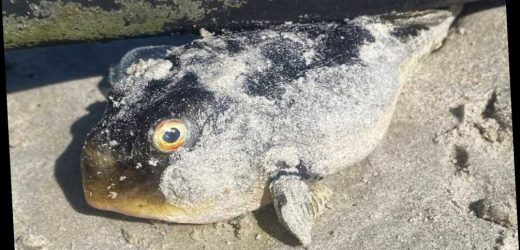HUNDREDS of bizarre sea creatures armed with toxins "deadlier than cyanide" have been found washed up on a beach by a Brit.
Scientist Tess Gridley made the terrifying discovery at Muizenberg Beach in Cape Town, South Africa, while out walking with her family.
Now marine experts have identified the bizarre looking creatures as lethal evil-eye pufferfish and have warned locals to steer clear.
Dr Gridley, who moved to Africa from Sheffield more than a decade ago, estimated that hundreds had become beached on the sands.
"The beach is 200 metres from our house and we were on a family walk," she said.
"I can't say how many were there as I only looked in a small area – I was with my kids and dog, and prepping for fieldwork so it was a short visit.
"But if you did count it would have exceeded hundreds."
The South Africa's Department of Environment, Forestry and Fisheries said the species carried a killer neurotoxin called tetrodotoxin.
It's a poison more lethal than cyanide and it causes death by respiratory failure after paralysing the diaphragm.
The ministry's statement read: "The fish mortalities in False Bay are exclusively of the evil-eye pufferfish with counts of 300 to 400 dead fish per km of shore.
"These dead fish all carry the deadly neurotoxin tetrodotoxin and should not be eaten; death comes usually by cardiac arrest.
"Beach dog walkers are strongly advised to keep their pets away from them.
"If one's dog does eat whole or part of a pufferfish, immediately induce vomiting and rush your pet to the vet."
One pet has already been killed as a result of the mass stranding, according to the AfriOceans Conservation Alliance, a local NGO.
Meanwhile, the cause of the incident remains a mystery.
Previous mass strandings have been caused by red tides – an algal bloom that changes the water's colour, and which produces natural toxins.
However, the ministry statement notes that "there are no reports of any adverse water conditions or red-tide toxins that may have caused this".
It's also possible that the fish were blown to shore after puffing themselves up, either during a mass courtship or as a response to big waves.
In any case, Dr Gridley – who studies marine life as part of the Sea Search organisation – believes the public has a part to play in future strandings.
"Keep a look out and report what you see," the mum-of-two said.
"Don't be alarmed, these events happen from time to time in natural systems.
"There is now an important role for citizen scientists in reporting these events through social media. We are learning a lot more about the marine environment these days from such reports.
"If possible, collect photos and videos which can then help to identify species, and offer interesting insights into what's living in our oceans."
Source: Read Full Article








